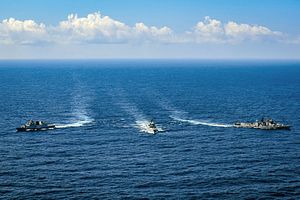Over the past week, India and Singapore have engaged in a series of defense-related interactions. While these are only a few of the interactions the sides currently have with each other, they have nonetheless spotlighted some of the ongoing activity in the security relationship amid wider regional and international developments in the wider Indo-Pacific region.
India and Singapore already enjoy a close defense relationship. Apart from the bilateral significance of the relationship, which includes not just exchanges, visits, and exercises, but also opportunities for the Singapore military to train in India, India-Singapore security cooperation is also among the key relationships being watched as patterns of collaboration evolve in the wider Indo-Pacific as well. Last year, the holding of the defense minister’s dialogue between the two sides was closely watched for developments on these fronts, with both sides inking a new naval pact and the headlines focused on the Indian Navy’s access to Changi Naval base (See: “Why The New India-Singapore Naval Pact Matters”).
That has continued on into 2018. India has continued to advance its own contributions to the Indo-Pacific including in Southeast Asia, with Prime Minister Narendra Modi delivering a keynote address at this year’s Shangri-La Dialogue in Singapore and hosting all ten ASEAN member states in New Delhi for India’s Republic Day for the first time as part of the ongoing Act East Policy. And Singapore under its ASEAN chairmanship in 2018 has also looked to build out its key defense focus areas – including counterterrorism, maritime security, and confidence-building measures in the security realm – while strengthening ties with neighboring states and major powers including India.
The two countries conducted this year’s iteration of the Singapore-India Maritime Bilateral Exercise (SIMBEX) from November 10 to 21, and they also held the third iteration of the India-Singapore Defense Minister’s Dialogue on November 20 in Visakhapatnam in India.
The interactions spotlighted both the overall significance of the bilateral relationship for both sides as well as the increasing regional importance of India-Singapore defense ties as well. On the former, some of the developments were more incremental, be it the expansions of exercises or the renewal or inroads made on agreements. For instance, SIMBEX, which was at its 25th iteration this year in the Andaman Sea and Bay of Bengal, saw close to 30 participating assets from the Republic of Singapore Navy (RSN) and the Indian Navy (IN), the largest number of assets from both navies thus far.
The renewal of the bilateral agreement for the conduct of joint army training and exercises in India reinforced the value Singapore receives from India serving as one of several places where the land-starved city-state can train its military. Both sides have also continued to make progress on several areas within their defense relationship, including navy cooperation, with an example being the conclusion of the Navy Implementing Arrangement Concerning Mutual Coordination, Logistics and Services Support in June 2018, which had followed the pact mentioned earlier in 2017.
The interactions also spotlighted ongoing and potential regional collaboration as well. Apart from reaffirming joint support for areas such as regional confidence-building measures and freedom of navigation and overflight in line with international law, the joint statement between the two sides following their defense ministers’ meeting also made reference to the first iteration of the trilateral maritime exercise India will conduct with Singapore and Thailand in the Andaman Sea. Singapore’s Defense Minister Ng Eng Hen also said Singapore was supportive of India’s vital security of the “Indo-Pacific region,” in recognition of the ongoing rising conversation of the strategic concept as well as the reality of the interconnectivity between the two regions including in sea lines of communication.
To be sure, officials on both sides would acknowledge that there remain lingering challenges with respect to implementing some of the specifics of their security collaboration, and that there are limits to the extent of strategic alignment between the two countries. Nonetheless, the points of convergence will continue to be notable to observe in the context of both bilateral ties as well as wider regional and international developments.

































